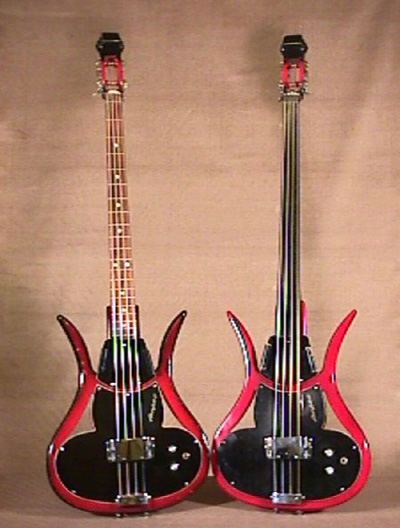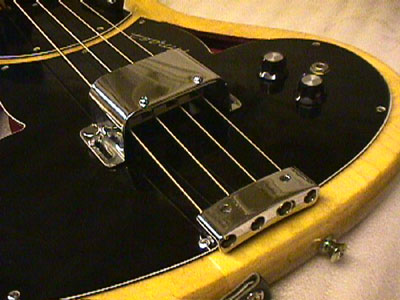
In My Collection:
On the left is ASB-1 #928. When I bought it, it was all original, but it had a stripped truss rod, and the paint was in poor shape. In '2000, I did a full restoration on it and sold it.
On the right is AUSB-1 #1060, which I bought in '98 after many years of searching for one.
Its body has been repainted all red, and the pickguard is heavily worn, but it plays well
and sounds great. I'm going to repaint the body back to the original sunburst scheme.
Sorry, these instruments are not for sale!!

The tailpiece of the Devil Bass is the same part as on the AEB-1/AUB-1, but it's
mounted on the surface of the body. The instrument's serial number is stamped on the underside,
so you have to look into the gap underneath to read it.
Vintage Ampeg Models:
Vintage Ampeg Main Page
AEB-1 & AUB-1
AMB-1 & AMUB-1
SSB & SSUB Short Scale Basses
General Information On Vintage Ampegs:
Setup, Maintenance & Technical Issues
Restorations & Parts
|
|
The ASB-1 (fretted) and AUSB-1 (fretless) Scroll Basses are a limited production variation on
the basic design of the AEB-1/AUB-1. They were introduced around December '66, which is about
six months after the AEB-1/AUB-1, and were made for about a year. The most distinctive feature
is the unusual body, with two long, skinny, outward-curving horns and triangular cutouts that
go all the way through the back. For obvious reasons, they've have acquired the nicknames of
"Devil Bass" or "Longhorn Bass". I've never been able to find out what "ASB" stands for.
The Devil Bass was the brainchild of an Ampeg employee named Mike Roman, who was inspired by
the DanElectro Longhorn basses. He finally convinced Everett Hull to let him develop and build
them as an optional model. They were doomed from the start. Nobody at Ampeg except Mike liked
them, and dealers were sending them back. Customers were just beginning to accept the unusual
appearance of the AEB-1, but they thought the Devil Bass was way too weird.
Devil Basses were made randomly from late '66 through late '67, in small batches. It's
interesting that some of them are beautiful, and others are poorly made. The earlier ones have
a lot of red on the body, including red on the front and back faces of the horns. The later
ones, with serial numbers over 1000, all have much more black around the edges, with the horns
being entirely black. The later ones also seem to be higher quality and have been kept in
better condition over the years. At that time, in late '67, they may have just been made up
on special order.
At least one Devil Bass was made with an asymmetrical body, where the upper half of the body
including the upper horn is shifted about 2" towards the headstock. A photo of this instrument
appears in a late '66 Ampeg brochure, so it was probably an early prototype. If anyone has
any information about a Devil Bass like this, please tell me!
Very few Devil Basses are in good condition today, and they rarely appear for sale. They're
mysterious and charming, but they're also heavy and clumsy to play. I don't know of anyone who
actually plays one in regular gigs. So, most of them have just been sitting around in closets
and attics, and the paint is usually cracked and peeling off. The AUSB-1 fretless Devil Bass
is particularly rare; I currently only know of five of them.
The neck, "mystery" pickup, and hardware of the Devil Basses are all almost the same as
the AEB-1/AUB-1. There are actually a few small differences between Devil Bass and
AEB-1/AUB-1 necks, for example, all of the frets on Devil Bass necks are shifted 1/4"
closer to the body. This was probably done to compensate for an error in the position of
the bridge and mystery pickup on the body.
The bodies of early Devil Basses with serial numbers under #1000 are made of maple with a
birch plywood back, similar to the AEB-1/AUB-1. However, later ones are cut from solid maple,
similar to the AMB-1/AMUB-1 that would appear in '68. The Devil Bass body extends farther
back than the AEB-1/AUB-1, so the tailpiece bolts down to the surface of the body, rather
than being mounted on the overhanging steel posts like the AEB-1/AUB-1. The tailpiece itself
is the same part as on the AEB-1/AUB-1.
The serial number on a Devil Bass is on the underside of the tailpiece, so you have to peer
into the gap between it and the body, or unscrew it and raise it up to read it. Because the
Devil Basses use the same tailpiece as the AEB-1/AUB-1, the serial numbers are all mixed in
together. They probably had bins of tailpieces on the shelf, and whenever orders came in for
Devil Basses, they just grabbed the next one. The lowest serial number I've heard so far on
a Devil Bass is #531, and the highest is #1149. In between, the numbers seem to be clustered
in little groups of 3-6 instruments.
I still don't know how many Devil Basses were made, but I estimate that it was about 100 total;
75 fretted ASB-1's and 25 fretless AUSB-1's. I currently own ASB-1 #1098, and
AUSB-1 #1060.
Yes, I am currently working on the design of a new generation of Devil Basses, which I hope to
have in production someday soon. I'll be posting information on this site as the first prototypes
come together.
|
|

